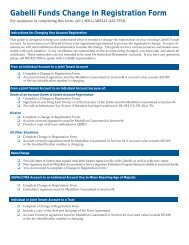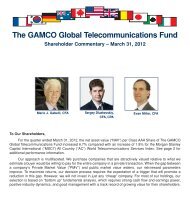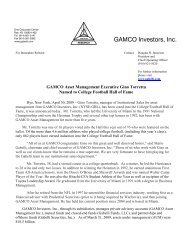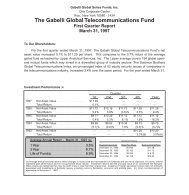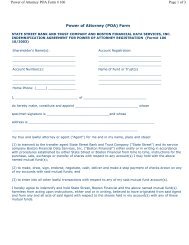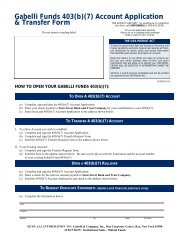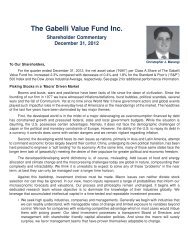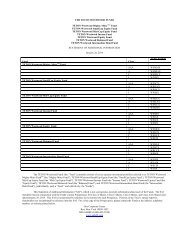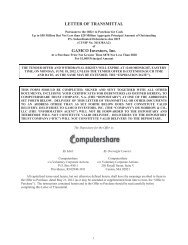FORM 10-K/A GAMCO Investors, Inc. - Gabelli
FORM 10-K/A GAMCO Investors, Inc. - Gabelli
FORM 10-K/A GAMCO Investors, Inc. - Gabelli
- No tags were found...
You also want an ePaper? Increase the reach of your titles
YUMPU automatically turns print PDFs into web optimized ePapers that Google loves.
ITEM 9:<br />
CHANGES IN AND DISAGREEMENTS WITH ACCOUNTANTS ON ACCOUNTING AND FINANCIAL DISCLOSURE<br />
None.<br />
ITEM 9A: CONTROLS AND PROCEDURES<br />
(a) Evaluation of Disclosure Controls and Procedures<br />
Management, with the participation of the Chief Executive Officer and under the supervision of the Chief Financial Officer, has evaluated the effectiveness of the Company’s<br />
disclosure controls and procedures, as such term is defined in Rules 13a-15(e) and 15d-15(e) under the Securities Exchange Act of 1934, as amended (the “Exchange Act”), as of<br />
December 31, 2006. In conducting the aforementioned evaluation and assessment, management identified two material weaknesses in internal control over financial reporting during<br />
the course of the 2006 audit. Accordingly, because of these two material weaknesses, management concluded that the Company’s disclosure controls and procedures were not<br />
effective as of December 31, 2006.<br />
Management did not have adequate controls in place to ensure that there was no more than a remote likelihood that a material misstatement of the annual or interim consolidated<br />
financial statements would be prevented or detected as it relates to: (1) the evaluation of and accounting for certain non-routine transactions in accordance with U.S. generally<br />
accepted accounting principles and (2) the reporting of individual assets and liabilities of certain investment accounts in the consolidated financial statements relating to the accounting<br />
treatment and financial statement presentation of certain of the Company’s proprietary investments. We initially incorrectly recorded the assets and liabilities of certain proprietary<br />
accounts on a net basis as we were accounting for them in the same manner as we account for an investment in a non-consolidated partnership. Whereas these proprietary<br />
investment accounts are not partnerships but are in fact managed trading accounts <strong>10</strong>0% owned by GBL, upon closer examination of our accounting policy, it was subsequently<br />
determined that they should be recorded on a gross basis in accordance with APB <strong>10</strong> and because they do not fall under FASB Interpretation 39 exceptions to APB <strong>10</strong>.<br />
As a result of the first material weakness, the Company restated its December 31, 2005 amounts in the consolidated financial statements. This deficiency resulted from management<br />
not having a process in place to properly identify and evaluate the accounting treatment for and financial statement presentation of certain proprietary investments. These proprietary<br />
investments were reported on a net asset basis but should have been reported on a gross asset and liability basis. In the consolidated statements of financial condition, the assets<br />
and liabilities (primarily short positions and margin) associated with these investment accounts were netted. All required adjustments were made to the December 31, 2006<br />
consolidated financial statements prior to issuance. The effects of the restatement on the December 31, 2005 consolidated financial statements is as follows: Cash and cash<br />
equivalents, investments in securities, receivable from brokers and other assets increased by $2.5 million, $20.4 million, $1.3 million, and $0.1 million, respectively, and investments<br />
in partnerships and affiliates decreased by $17.1 million for a net increase in total assets of $7.2 million. Accrued expenses and other liabilities, payable to brokers, and securities<br />
sold, not yet purchased increased $0.1 million, $3.9 million and $3.2 million, respectively, for a total increase in liabilities of $7.2 million.<br />
In the second material weakness relating to the evaluation of and accounting for certain non-routine transactions in accordance with U.S. generally accepted accounting principles,<br />
the Company’s control deficiencies over accrual of compensation expense for investment partnerships compensation were contemplated in the determination of the material<br />
weakness evaluation. As a result of the second material weakness, the Company filed Form <strong>10</strong>-K/A of <strong>GAMCO</strong> <strong>Investors</strong>, <strong>Inc</strong>. on August 9, 2007, which constituted<br />
Amendment No. 1 to the Company’s Annual Report on Form <strong>10</strong>-K for the year ended December 31, 2006 to restate the Financial Statements and amend Management’s<br />
Discussion and Analysis of Financial Condition and Results of Operations (<strong>Inc</strong>luding Quantitative and Qualitative Disclosure about Market Risk) in Part I, Items 1 and 2,<br />
respectively, to reflect the reversal of certain previously-accrued expenses for investment partnerships compensation.<br />
(b) Management’s Report on Internal Control Over Financial Reporting<br />
The Company’s management is responsible for establishing and maintaining adequate internal control over financial reporting, as such term is defined in Rule 13a-15(f) of the<br />
Exchange Act. Management, with the participation of the principal executive officer and under the supervision of the principal financial officer, the Company conducted an<br />
evaluation of the effectiveness of the Company’s internal control over financial reporting as of December 31, 2006, as required by Rule 13a-15(c) of the Exchange Act. There are<br />
inherent limitations to the effectiveness of any system of internal control over financial reporting, including the possibility of human error and the circumvention or overriding of the<br />
controls and procedures. Accordingly, even effective internal control over financial reporting controls can only provide reasonable assurance of achieving their control objectives. In<br />
making its assessment of the effectiveness of its internal control over financial reporting, the Company used the criteria set forth by the Committee of Sponsoring Organizations of the<br />
Treadway Commission (COSO) in Internal Control-Integrated Framework.<br />
A material weakness (within the meaning of the Auditing Standard No. 2, An Audit of Internal Control Over Financial Reporting Performed in Conjunction With an Audit of<br />
Financial Statements, of the Public Company Accounting Oversight Board (United States)) is a significant deficiency, or combination of significant deficiencies, that results in there<br />
being more than a remote likelihood that a material misstatement of the annual or interim financial statements will not be prevented or detected. Based on the definition of “material<br />
weakness”, the deficiencies described below indicate the existence of material weaknesses in the Company’s design or operation of internal control over financial reporting. Based<br />
on that, management concluded that the following material weaknesses existed in the Company’s internal control over financial reporting at December 31, 2006 and disclosed this<br />
to the Audit Committee and to the independent registered public accountants.<br />
Management did not have adequate controls in place to ensure that there was no more than a remote likelihood that a material misstatement of the annual or interim financial<br />
statements would be prevented or detected as it relates to two items. First, there was a material weakness relating to the reporting of individual assets and liabilities of certain<br />
proprietary investment accounts in accordance with U.S. generally accepted accounting principles. In the consolidated statement of financial condition, the assets and liabilities<br />
(primarily short positions and margin) associated with these proprietary investments were reported on a net basis, rather than reported on a gross basis. Next, there was a material<br />
weakness relating to the evaluation of and accounting for certain non-routine transactions in accordance with U.S. generally accepted accounting principles. All required<br />
adjustments were made to the December 31, 2006 consolidated financial statements prior to issuance.<br />
II-1



